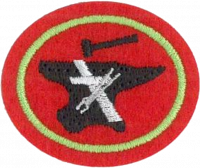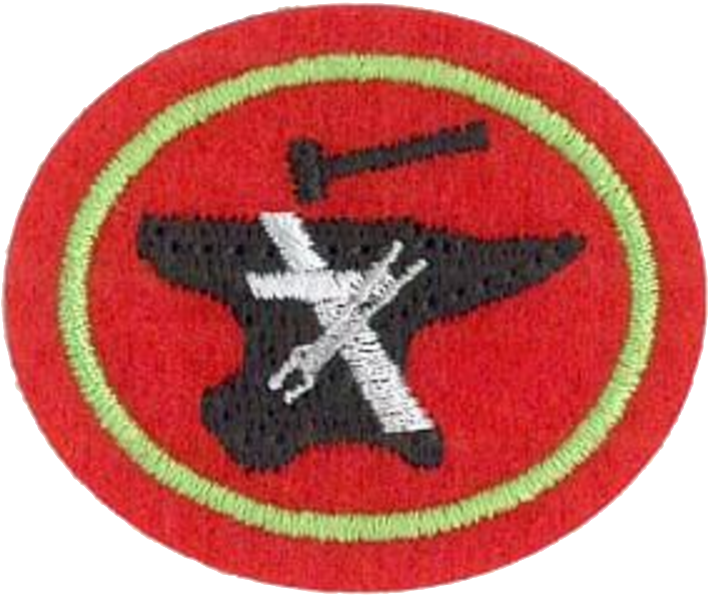Difference between revisions of "AY Honors/Blacksmithing/Requirements/es"
(Updating to match new version of source page) |
(Created page with "</noinclude>Combustible <noinclude>") |
||
| Line 18: | Line 18: | ||
<noinclude></noinclude><section end=req5 /></b> | <noinclude></noinclude><section end=req5 /></b> | ||
| − | :<b>a. <section begin=req5a /><noinclude> | + | :<b>a. <section begin=req5a /><noinclude></noinclude>Fragua |
| − | </noinclude> | + | <noinclude></noinclude><section end=req5a /></b> |
| − | <noinclude | ||
| − | |||
| − | :<b>b. <section begin=req5b /><noinclude> | + | :<b>b. <section begin=req5b /><noinclude></noinclude>Combustible |
| − | </noinclude> | + | <noinclude></noinclude><section end=req5b /></b> |
| − | <noinclude | ||
| − | |||
| − | :<b>c. <section begin=req5c /><noinclude> | + | :<b>c. <section begin=req5c /><noinclude></noinclude>Soplador (fuelle) y conductos de ventilación |
| − | </noinclude> | + | <noinclude></noinclude><section end=req5c /></b> |
| − | <noinclude | ||
| − | |||
| − | :<b>d. <section begin=req5d /><noinclude> | + | :<b>d. <section begin=req5d /><noinclude></noinclude>Yunque |
| − | </noinclude> | + | <noinclude></noinclude><section end=req5d /></b> |
| − | <noinclude | ||
| − | |||
| − | :<b>e. <section begin=req5e /><noinclude> | + | :<b>e. <section begin=req5e /><noinclude></noinclude>Martillo |
| − | </noinclude> | + | <noinclude></noinclude><section end=req5e /></b> |
| − | <noinclude | ||
| − | |||
| − | :<b>f. <section begin=req5f /><noinclude> | + | :<b>f. <section begin=req5f /><noinclude></noinclude>Tenazas |
| − | </noinclude> | + | <noinclude></noinclude><section end=req5f /></b> |
| − | <noinclude | ||
| − | |||
| − | :<b>g. <section begin=req5g /><noinclude> | + | :<b>g. <section begin=req5g /><noinclude></noinclude>Tornillo de banco |
| − | </noinclude> | + | <noinclude></noinclude><section end=req5g /></b> |
| − | <noinclude | ||
| − | |||
| − | :<b>h. <section begin=req5h /><noinclude> | + | :<b>h. <section begin=req5h /><noinclude></noinclude>Gafas protectoras |
| − | </noinclude> | + | <noinclude></noinclude><section end=req5h /></b> |
| − | <noinclude | ||
| − | |||
| − | :<b>i. <section begin=req5i /><noinclude> | + | :<b>i. <section begin=req5i /><noinclude></noinclude>Tapones para los oídos |
| − | </noinclude> | + | <noinclude></noinclude><section end=req5i /></b> |
| − | <noinclude | ||
| − | |||
<b>6. <section begin=req6 /><noinclude></noinclude>Identificar las partes de un yunque de patrón de Londres e identificar sus usos: | <b>6. <section begin=req6 /><noinclude></noinclude>Identificar las partes de un yunque de patrón de Londres e identificar sus usos: | ||
Revision as of 16:28, 16 May 2021
Nivel de destreza
2
Año
2015
Version
21.12.2025
Autoridad de aprobación
División Norteamericana
1. Definir herrero y la herrería.
2. Aunque tanto la forja y fabricación pueden ser una parte de la herrería, sus proyectos pueden o no incluir la fabricación. Discutir con su instructor de las diferencias básicas entre la forja y la fabricación y ser capaz de explicar las diferencias.
3. Discutir con su instructor acerca de las reglas de seguridad para la herrería. Asegurarse de entender por qué son importantes y explicarlas o demostrarlas cuando se le pregunte.
4. Mientras discute con su instructor el proceso del tratamiento de metales, desarrollar una comprensión básica de los principios de endurecer y templar metales.
5. Identificar y explicar los nueve elementos básicos requeridos para la herrería.
- a. Fragua
- b. Combustible
- c. Soplador (fuelle) y conductos de ventilación
- d. Yunque
- e. Martillo
- f. Tenazas
- g. Tornillo de banco
- h. Gafas protectoras
- i. Tapones para los oídos
6. Identificar las partes de un yunque de patrón de Londres e identificar sus usos:
- a.
The body (and base):
- b.
The horn
- c.
Table or step
- d.
The face
- e.
The Hardie or Hardy hole
- f.
The Pritchel hole
7.
Explain the two basic classes of forges, (solid fuel and gas), and demonstrate ability to identify the parts of the one you will be using.
- a.
Solid Fuel Forge
- i.
Blower
- ii.
Fire Pot or Pan
- iii.
Tuyere
- iv.
Ash Dump
- v.
Clinker Breaker
- vi.
Tuyere Plate
- b.
Gas Forge
- i.
Forge or Fire box
- ii.
Hose
- iii.
Pressure Gauge
- iv.
Regulator
- v.
Burner
8.
Identify the basic parts of a hammer and list the basic classes of hammers used in blacksmithing. (The shape of a hammer reflects the task that it is designed to do).
- a.
Parts of a hammer
- i.
Handle
- ii.
Head:
1) The FACE:
2)The PEEN:
- b.
Types of blacksmith hammers
- i.
Cross Peen
- ii.
Angle Peen
- iii.
In-line or Straight Peen
- iv.
Ball Peen
9.
Discuss tooling with your instructor, and explain how it is used. Although many types of tooling have handles how is tooling different than a hammer?
10.
With your instructor, discuss and review the basic types of tongs available in blacksmithing. Tongs are classified by the shape (or description) of the jaw, which affect their use. Some basic types are:
11.
Discuss how to properly start and put out a fire in the forge you are using.
- a.
Solid Fuel:
- ii.
Put Out
- b.
Gas
- i.
Start
- ii.
Turn Off
12.
Discuss how to PROPERLY clean and maintain the blacksmithing equipment you are using.
- a.
Forge
- b.
Anvil
- c.
Hammers
- d.
Tongs
13.
While each hammer, tong, and tool serves a specific function there are only a few foundational skills of a blacksmith. Discuss with your instructor the three to five skills they feel are most important for their style of blacksmithing.
- a.
Drawing
- b.
Tapering
- c.
Upsetting
- d.
Spreading
- e.
Twisting
- f.
Bending
- g.
Drifting (or Punching)
- h.
Slitting (or Splitting)
14.
With supervision make two projects. You will be using low carbon steel at least ¼ inch thick and utilizing techniques your instructor will teach you. These projects need to include the following techniques:
- a.
Draw out the end of a square piece by forging a round taper, and placing a finial (Curly queue) on the end.
- b.
Use the horn of the anvil to forge a U-shaped bend.
- c.
Form a decorative twist in a piece of square steel.
15.
Choose one of the following:
- a.
Prepare a worship talk discussing blacksmithing from the Bible and/or the spirit of prophecy and discuss its application to our lives.
- b.
Write a 250 plus word paper about metal processing or blacksmithing from the Bible and/or the spirit of prophecy and its application to today.
- c.
Using your artistic ability, draw, create, make a short video etc., using blacksmithing from the Bible and/or the Spirit of Prophecy to illustrate a spiritual lesson and present to your pathfinder group.
16.
Blacksmithing and metal working are ancient arts. When where they first mentioned in the Bible? What kind of things were made?
17.
There are many references to “smiths” in the Bible. What is the significance of the blacksmith in the following texts:
- a.
- b.
- c.


